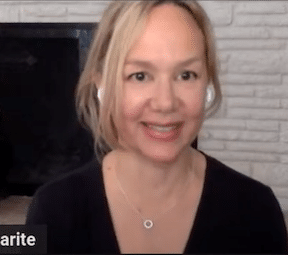Model your storyline after one of these 7 major plot archetypes
First in a series on how to take a deeper dive into Marlowe’s A.I. reports. Below is an extended explanation of the narrative arc section of Marlowe Pro analyses — with takeaways for your storytelling.
Do most novels share certain storytelling patterns? More than three decades ago, Kurt Vonnegut toyed with the idea that stories have universal shapes. He suggested that, with few exceptions, the stories of classic and modern literature can be grouped into a handful of archetypes.
And now Marlowe, the new artificial intelligence from Authors A.I., has validated Vonnegut’s theory.
To authors, the idea of universal story archetypes seems a bit far-fetched on its surface, given the seeimingly millions of stories in the marketplace with their countless twists and turns. Can most popular fiction really be grouped into these crude buckets? We authors have a natural tendency to rebel at the idea that our stories can be pigeonholed or typecast. We resist the notion that our heartbreaking works of staggering genius can be considered anything but wholly original.
But that misses the point of archetypes. Let me explain by summarizing Vonngut’s observations about story shapes — and explain why his theories are still relevant to writers today. While we can’t show you how to write a novel that conforms to one of these story shapes, we can provide plenty of examples and give you an A.I. tool (Marlowe Pro) that graphs your own novel’s narrative arc.
Perennial rhythms to the stories we tell
Vonnegut argued that classic stories from popular culture through the ages had predictable plot arcs that could be graphed on a piece of paper, on a blackboard or by a computer. He even proposed a master’s thesis on the topic, which the faculty committee at the University of Chicago rejected in their inimitable wisdom.
Vonnegut kept returning to his idea about story shapes throughout his career. He built a lecture around the theory and took it on the road. With his wry sense of humor, Vonnegut delighted a student audience in a 1985 lecture captured on video that made its way onto YouTube decades later:
Stories have very simple shapes that computers can understand, Vonnegut argued, adding dryly, “I have tried to bring scientific thinking to literary criticism, and there’s been very little gratitude for this.”
In his writings and lectures, Vonnegut observed that a graph of a story could be charted along a vertical axis. Scenes that evoke good fortune, health and happiness go at the top while events that result in death, disease, poverty or other ill fortune fall below the median line. The horizontal axis denotes narrative time, from the beginning to end of the story. As the plot drives forward, the threads of a story typically take us on a journey through crises, complications, dramatic turns and resolutions.
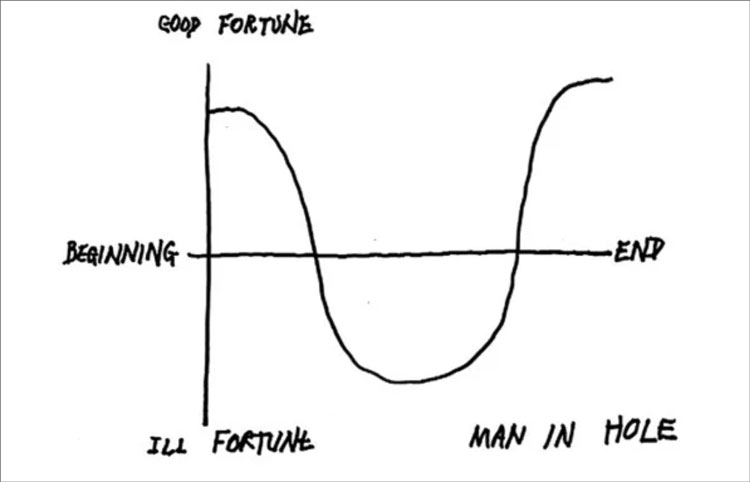
Over time, Vonnegut developed a theory of eight universal story shapes. As he doodled, he often liked to scribble plot shapes. Here are two drawings he made of two of his favorite archetypes, which he called Man in Hole and Boy Meets Girl.
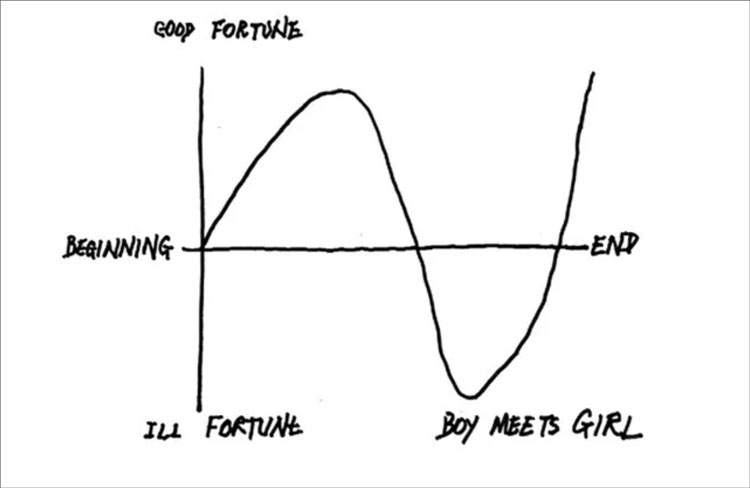
An A.I. goes to work to assess Vonnegut’s idea
Fast forward three decades. The video of Vonnegut talking about his theory of story shapes caught the eye of scholar and data scientist Matthew Jockers, author of two books on text mining. Jockers went on to write The Bestseller Code (co-authored by Jodie Archer) with the goal of identifying the features that propel a book to the bestseller lists. Based on his research, he wrote an algorithm that was able to predict with 83% accuracy whether a title would be included on the New York Times adult fiction bestseller list or not – based strictly on the contents of the novel. Plot structure and emotional story beats are among the key ingredients, as Vonnegut argued.
Jockers and the data team at the tech startup Authors A.I. have recently created an artificial intelligence named Marlowe that analyzes fiction manuscripts. And after ingesting thousands of popular fiction titles, it turns out that Marlowe concurs with the late Professor Vonnegut about story shapes at a high level, if not in all the specific details.
So what has Marlowe deduced about story shapes?
Here are the major story shapes – visual abstracts of plot archetypes – that Jockers’ artificial intelligence has identified in modern fiction, with recent examples drawn from the bestseller lists:
Story shape #1: Emergence

There’s a broad swath of stories with a lighter touch where the narrative drive centers on the main character’s journey of transformation or her triumph over adverse circumstances. The stories often start with a negative emotional valence, with the protagonist in a tight spot or feeling lonely, sickly or unappreciated. Characters gradually overcome a perplexing or complex series of problems, with the plots often featuring miscommunications, separations and other obstacles until the protagonists achieve success (love, wealth, wisdom) and arrive at a happy ending.
Most romance literature fits this story shape. Broadly speaking, these novels have an overarching plot shape of two lonely souls who meet each other, fall in love, encounter a serious setback or tragedy, overcome it and live happily ever after.
Vonnegut called this a Boy Meets Girl story shape, though he noted that it needn’t be about a boy or a girl. Others have called this kind of story Classical Comedy. The Authors A.I. team of authors and data scientists determined that, while humor is often a feature of this story shape, it is not the defining characteristic. Jockers said that Emergence connotes a journey through difficult times toward a positive outcome.
Classic examples of this shape include Shakespeare’s Much Ado About Nothing and George Barr McCutcheon’s Brewster’s Millions. In modern culture, films like Jerry Maguire and most romantic comedies fit this archetype. In recent literature, John Irving’s The Cider House Rules, Bruce W. Cameron’s A Dog’s Purpose, Danielle Steel’s The Gift and William P. Young’s The Shack fit the Emergence story shape.
Story shape #2: Man in the Hole

Jockers and his team named this story shape in honor of Vonnegut, who reminded us that this kind of story doesn’t necessarily involve either a man or a hole. (Other theorists have offered different names for this story shape.)
In this story, the protagonist confronts an antagonist or a threat to a person or society at large that must be thwarted. The threat may be a madman, a corporation, a fire-breathing dragon or any formidable foe. The main character must pursue and extinguish the threat, at great personal risk, turning ill fortune back to good – and resulting in a lasting change to himself.
Vonnegut summed up Man in the Hole this way: “Somebody gets into trouble, gets out of it again.”
Classic novels with this story shape include Bram Stoker’s Dracula, James Joyce’s A Portrait of the Artist as a Young Man, Arthur Conan Doyle’s The Adventures of Sherlock Holmes and H.G. Wells’ The War of the Worlds. Modern examples include John Grisham’s The Runaway Jury, Matthew Quick’s The Silver Linings Playbook, Anita Diamant’s The Boston Girl, Charlaine Harris’s From Dead to Worse, Kathryn Stockett’s The Help and Dennis Lehane’s Sacred.
Story shape #3: The Quest

We’re all familiar with quest stories, where the protagonist and companions set off on an adventure to retrieve a valuable object or achieve some other tangible goal despite formidable obstacles along the way. The Greek myth of Jason and the Golden Fleece, The Wizard of Oz, Raiders of the Lost Ark and Star Wars are all examples of a Quest saga. Joseph Campbell’s well-known Hero’s Journey is basically a Quest story.
In a computer graph, Quest stories’ narrative arcs resemble the letter M. According to the Marlowe A.I., Richard Adams’ Watership Down, most of J.K. Rowling’s Harry Potter books, Rick Riordan’s The Lightning Thief, Salman Rushdie’s The Satanic Verses, Jonathan Franzen’s The Corrections, Emily Giffin’s Love the One You’re With, Donna Tartt’s The Goldfinch, Donald E. Westlake’s What the Worst That Could Happen and Steve Berry’s The Lincoln Myth have shapes that correspond to the Quest story archetype.
Story shape #4: Rags to Riches
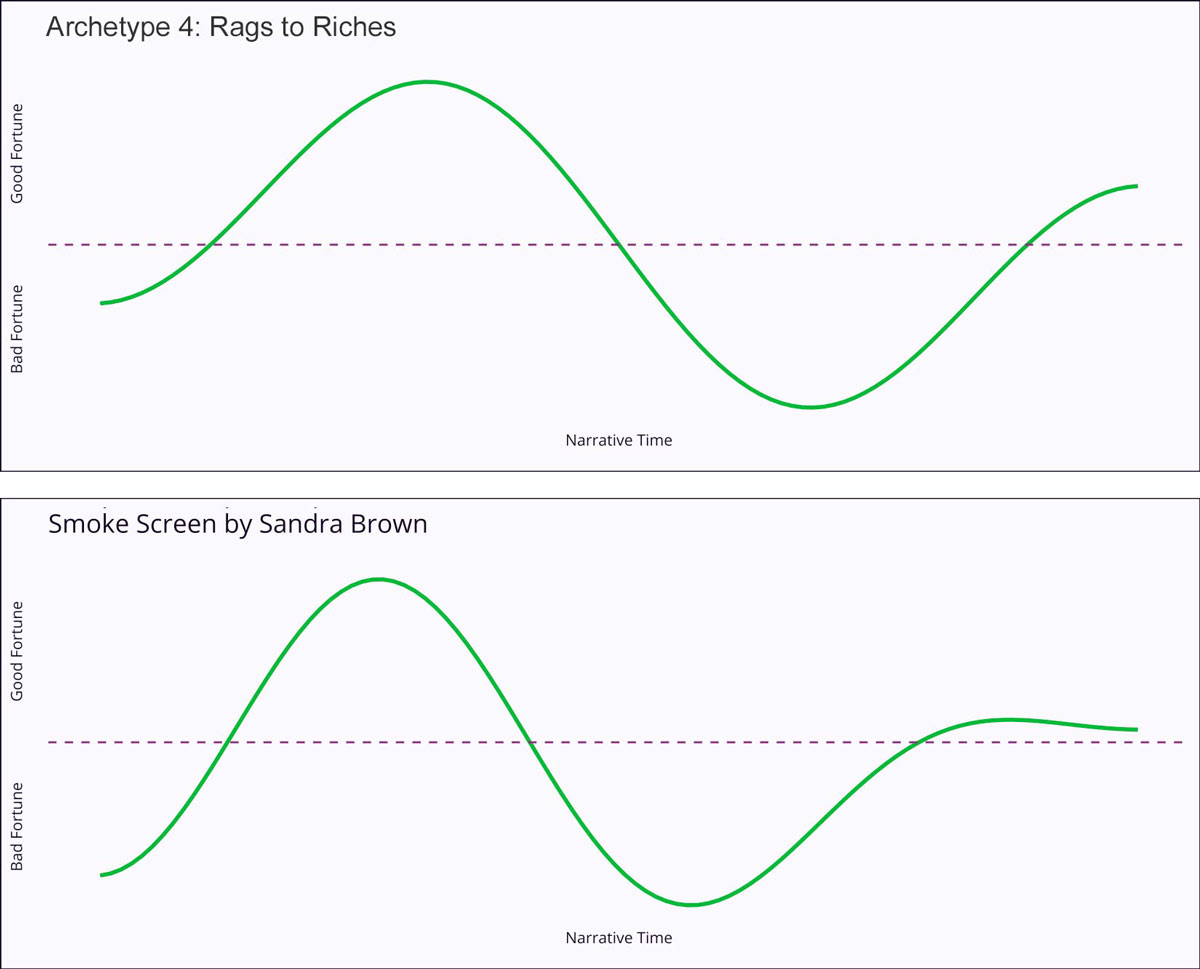
The idea here is that a main character (usually the protagonist) gains something she lacks through a happy twist of fate – wealth, prestige, love, power – loses it, then regains it at the end. The hero here is often an unremarkable or downtrodden person who has the potential for greatness and grasps the opportunity to fulfill that potential through luck or pluck. Some have called this story shape Coming of Age.
In his online masterclass, David Mamet describes the rags-to-riches tale as “an underdog story, wherein a simple, relatable character receives newly begotten privilege (whether via luck, conquest, or a magical trickster like a fairy godmother) and must balance the duties that come along with that privilege.”
Examples of Rags to Riches in classic literature include Charlotte Brontë’s Jane Eyre, Mark Twain’s The Prince and the Pauper and Charles Dickens’s David Copperfield. Modern examples include Amy Tan’s The Kitchen God’s Wife, Stephen King’s Misery, Robert Ludlum’s The Aquitaine Progression, Liane Moriarty’s Big Little Lies, Anita Shreve’s Testimony, Sandra Brown’s Smoke Screen and Paula Hawkins’s The Girl on the Train.
Story shape #5: Voyage and Return

In these tales, characters are plunged into a strange and foreign land, come to grips with it, confront setbacks and dark turns but wind up in the end with a return to safety and some form of normalcy – as well as achieving a degree of understanding during their journey from naïveté to wisdom.
Homer’s The Odyssey, Jonathan Swift’s Gulliver’s Travels, James Joyce’s Ulysses and H.G. Wells’ The Time Machine fit this story pattern. In more recent popular fiction, Andy Weir’s The Martian, Nicholas Sparks’ The Notebook, James Patterson’s Hope to Die, Ernest Cline’s Ready Player One, J.R.R. Tolkien’s The Hobbit, Laura Esquivel’s Like Water for Chocolate and Cormac McCarthy’s The Road use the Voyage and Return story archetype – whether the authors knew it or not.
Story shape #6: Rise and Fall
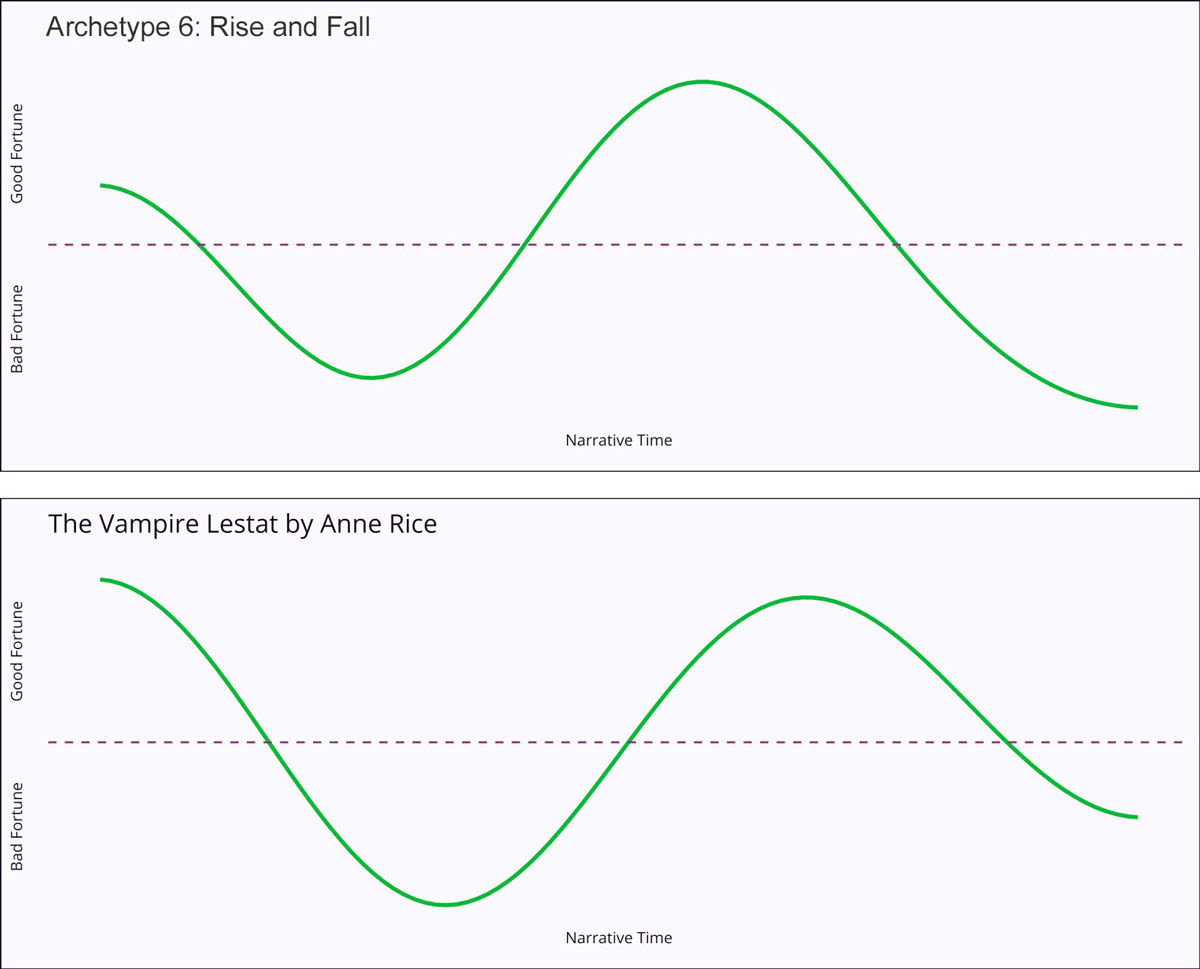
Marlowe parts ways with Booker and Vonnegut on this story shape. In these stories, things can start out in positive or neutral territory, a crisis confronts the main characters, they overcome it, things seem to be moving in the right direction but then something awful befalls them at the climax. Jockers speculates that the late Booker called this Rebirth because the plots tend to feature main characters who experience change, renewal or transformation. But those positive values are ultimately thwarted by outside forces. So Jockers and company are calling this story shape Rise and Fall.
In this archetype, a dark force creates a dip into negative emotional terrain in the first act as the protagonist’s values are tested, according to Marlowe’s data visualizations. The characters overcome that challenge at the heart of the plot and achieve some measure of success before things fall apart at the end.
Hans Christian Andersen’s The Snow Queen, Jane Austen’s Pride and Prejudice, French novelist Gabrielle-Suzanne Barbot de Villeneuve’s Beauty and the Beast and Frances Hodgson Burnett’s The Secret Garden are classic examples of this story shape. In modern times, E.L. James’ Fifty Shades of Grey, Hilary Mantel’s Wolf Hall, Stephen King’s The Stand, Jodi Picoult’s Leaving Time, Kate Morton’s The Forgotten Garden, Anne Rice’s The Vampire Lestat, Margaret Atwood’s The Handmaid’s Tale, Will Wight’s Unsouled, Jeffrey Deaver’s The Blue Nowhere, Lev Grossman’s The Magicians and Neal Stephenson’s Snow Crash are all examples of this story shape, the A.I. analyses say.
Story shape #7: Descent
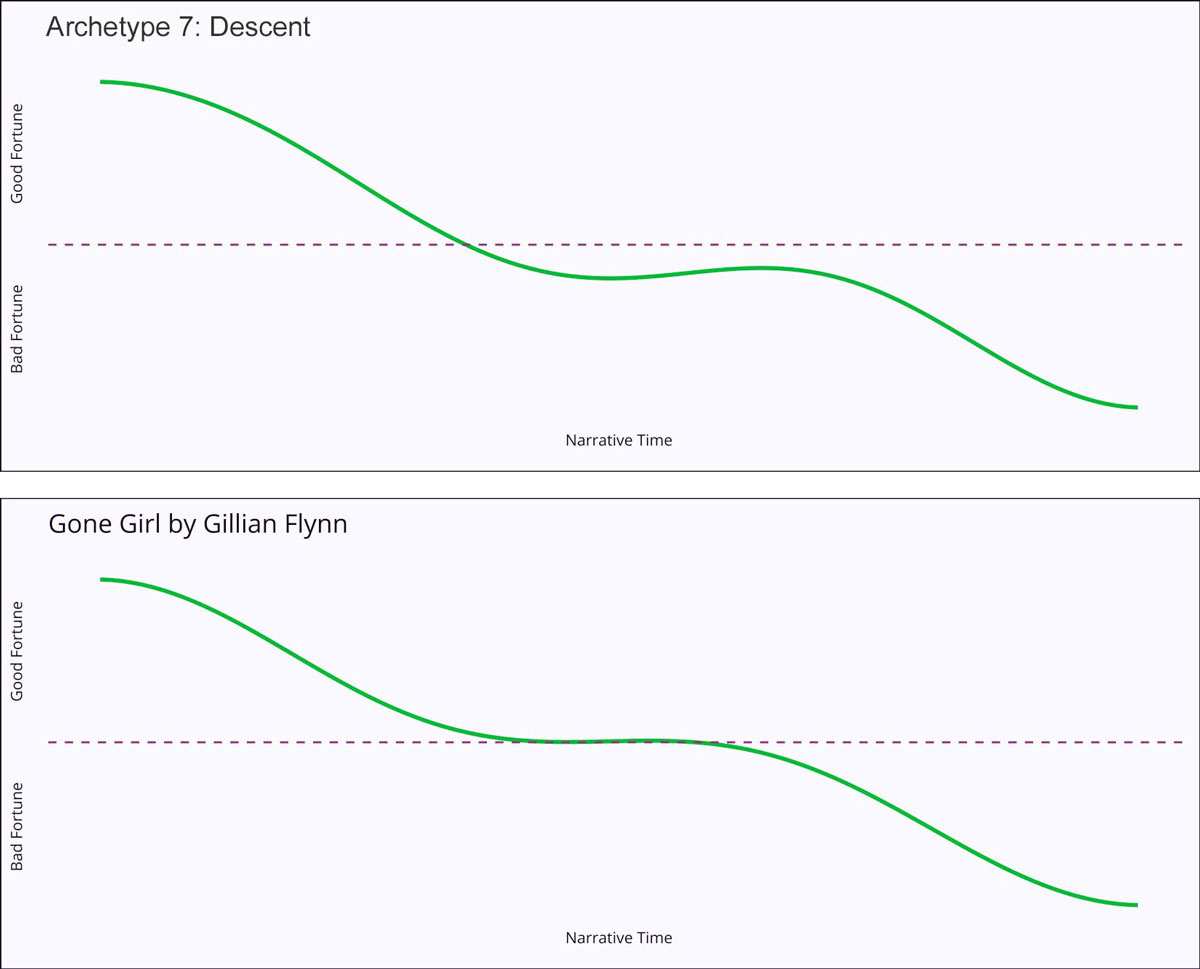
While other story archetypes see endings where the heroes triumph over powerful foes, this story pattern takes a darker turn and ends in loss or death. (Others have called this story shape Tragedy or From Bad to Worse.)
Shakespeare’s Romeo and Juliet, King Lear, Julius Caesar and Macbeth, Gustave Flaubert’s Madam Bovary and Oscar Wilde’s The Picture of Dorian Gray are examples of classic literature that fit this story archetype. Modern examples include Gillian Flynn’s Gone Girl, Lauren Weisberger’s The Devil Wears Prada, Scott Smith’s A Simple Plan, Mary Higgins Clarke’s Where Are the Children, Tom Clancy’s The Hunt for Red October, John D. MacDonald’s The Deep Blue Good-by, Candace Bushell’s Sex and the City, Mark Edwards’s The Magpies, Sara Shepard’s Pretty Little Liars and even Lilian Jackson Braun’s The Cat Who Could Read Backwards are all examples of the Descent story shape, according to Marlowe.
Using story shapes in your writing
Vonnegut, of course, wasn’t the first scholar to broach the idea of story shapes. Over the years, others have weighed in with their own takes. In 1959 William Foster-Harris distilled stories into three basic buckets: happy ending, unhappy ending and tragedy. Ronald B. Tobias identified 20 story forms in his book 20 Master Plots. In his 2004 book The Seven Basic Plots, Christopher Booker distilled novels into seven basic narrative forms (though his book actually offered nine in all).
Now add Marlowe the A.I. to the list of story shape theorists.
Jockers points out that as you study the masters, you may start to notice certain patterns emerge in their storytelling. For instance, Isaac Asimov tended to favor The Quest and Descent archetypes. John Grisham likes to use the Emergence and Descent archetypes. Dean Koontz typically evokes Rags to Riches. Stephen King studiously avoids Rags to Riches but uses most of the others. Danielle Steel also eschews Rags to Riches in favor of Man in the Hole. Mary Higgins Clark uses several but avoids Emergence and Rags to Riches. Jean Auel (who wrote the Clan of the Case bear books) favored Man in the Hole. Agatha Christie preferred Descent and Rise and Fall. Charles Dickens regularly turned to Descent.
“What’s fascinating is that if you pull back the camera and abstract the shapes sufficiently, our A.I. has identified the story archetypes that appear over and over across generations and across genres,” Jockers said. “Readers come to a novel with certain expectations. If you stray too far as an author, it can betray readers’ desires – or worse, bore the hell out of them. Literary experimentalists like James Joyce can get away with this sort of rule breaking. But Ulysses, for all its wonder, never made it onto tens of millions of readers’ nightstands.”
Jockers said his takeaway from the early analyses produced by Marlowe is that archetypes serve as just another tool to help writers form a conceptual framework for their storytelling.
“It’s important to keep in mind there is no one single ‘correct’ way to write a novel,” Jockers added. “Don’t become paralyzed with fear because your story doesn’t seem to match one of these story shapes. It’s important to look at story shapes not as formulas to copy but as storytelling guideposts to help keep the big picture in mind when writing your story.”
Put an artificial intelligence to work for you
In short, you need to decide where you want to wind up before filling in the details of how to get there. And you’ll want to find the story rhythms that work for you.
To try out Marlowe Pro and to see the narrative arc it detects in your novel, try it for a month for only $29.95 and run two Pro reports.





